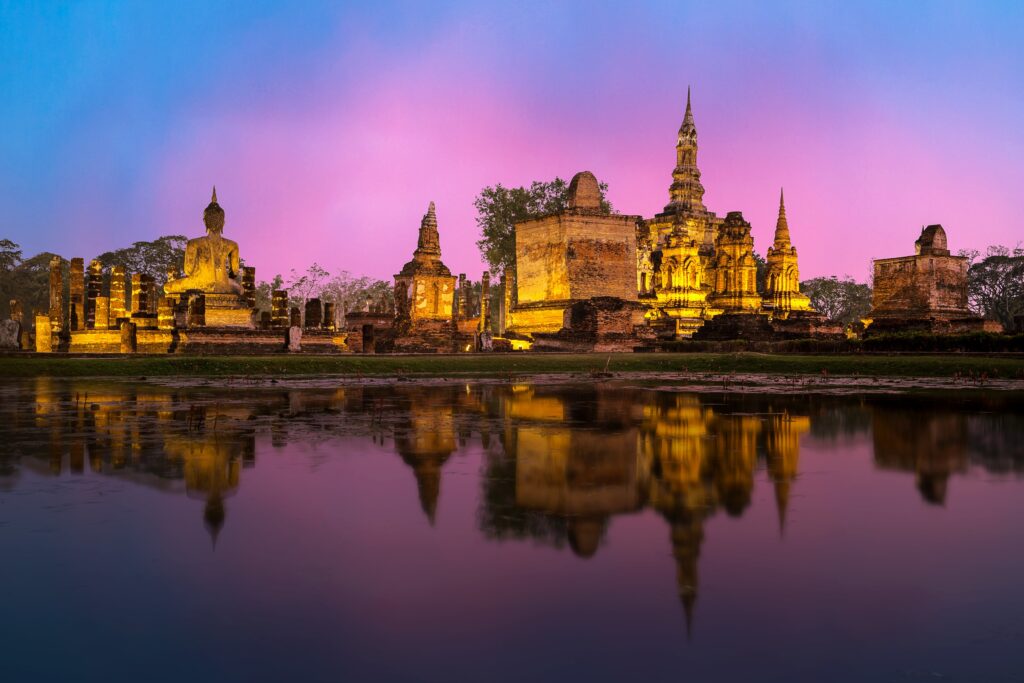Thailand Tourist Visa
Tourist Visa For Thailand
To obtain a tourist visa for Thailand, you will need to follow the guidelines set by the Royal Thai Embassy or Consulate in your country. Please note that visa requirements and processes may vary depending on your nationality. Here is a general overview of the tourist visa application process for Thailand:
Check visa requirements: Visit the website of the Royal Thai Embassy or Consulate in your country to verify the specific visa requirements for tourists. They will provide you with the necessary information regarding application forms, supporting documents, and fees.
Complete the application form: Fill out the visa application form accurately and legibly. You can usually download the application form from the embassy’s website or obtain it in person from the embassy or consulate.
Gather required documents: Prepare the supporting documents required for your visa application. Commonly requested documents include:
- Passport: Ensure your passport is valid for at least six months beyond your intended stay in Thailand.
- Passport-sized photos: Usually, two recent passport-sized photographs are required.
- Flight itinerary: Provide a copy of your confirmed round-trip ticket or itinerary.
- Accommodation details: Include a hotel reservation or an invitation letter if you’re staying with someone in Thailand.
- Financial proof: Show evidence of sufficient funds to cover your expenses during your stay in Thailand, such as bank statements or a bank certificate.
- Travel insurance: It is advisable to have travel insurance coverage for the duration of your trip.
Submit the application: Visit the Royal Thai Embassy or Consulate in person to submit your application along with the required documents. Some embassies may allow online or postal applications, so check their website for specific instructions.
Pay the visa fee: Pay the applicable visa fee, which varies depending on your nationality and the type of visa you are applying for. The fee is usually payable in cash or by credit card.
Wait for processing: The processing time for a tourist visa can vary, but it typically takes a few business days. During this period, the embassy or consulate will review your application and documents.
Collect your visa: Once your visa application is approved, collect your passport from the embassy or consulate. Your visa will be stamped inside your passport, allowing you to enter Thailand as a tourist.
It is important to note that visa requirements and procedures may change over time, so it is recommended to check the official website of the Royal Thai Embassy or Consulate in your country for the most up-to-date information before applying for a tourist visa.
Thailand’s Tourist Visa Requirements
The specific requirements for a tourist visa to Thailand can vary depending on your nationality and the duration of your intended stay. However, here are the general requirements for a tourist visa to Thailand:
Passport: Your passport must be valid for at least six months beyond your intended stay in Thailand and have at least one blank page for visa issuance.
Visa Application Form: Complete the visa application form accurately and legibly. You can usually obtain the form from the Royal Thai Embassy or Consulate in your country or download it from their official website.
Recent Photographs: Provide two recent passport-sized photographs taken within the last six months. The specific size and requirements may vary, so check with the embassy or consulate.
Flight Itinerary: Present a copy of your confirmed round-trip airline ticket or itinerary that shows your entry and exit dates from Thailand.
Accommodation Details: Provide proof of accommodation for your stay in Thailand. This can be in the form of a hotel reservation, a letter of invitation if staying with a Thai resident, or any other document that confirms your accommodation arrangements.
Financial Proof: Show evidence of sufficient funds to cover your expenses during your stay in Thailand. This can include bank statements, bank certificates, or a combination of cash and traveler’s cheques.
Travel Insurance: Although not always mandatory, it is highly recommended to have travel insurance that covers medical emergencies, accidents, and repatriation during your trip.
Visa Fee: Pay the applicable visa fee, which may vary depending on your nationality and the type of visa you are applying for. The fee is typically payable in cash or by credit card.
It is important to note that these requirements are general guidelines, and there may be additional documents or specific requirements depending on your circumstances. It is always advisable to check the official website of the Royal Thai Embassy or Consulate in your country for the most accurate and up-to-date information regarding tourist visa requirements for Thailand.
Thailand’s Most Popular Tourist Location
Thailand is renowned for its diverse attractions and popular tourist destinations. Here are some of the most well-known places to visit in Thailand:
Bangkok: The capital city of Thailand offers a mix of traditional and modern experiences. Explore the bustling street markets, visit ornate temples like Wat Arun and Wat Phra Kaew, cruise along the Chao Phraya River, and indulge in the vibrant nightlife and delicious street food.
Phuket: Known for its stunning beaches and vibrant nightlife, Phuket is one of Thailand’s most popular tourist destinations. Relax on the famous Patong Beach, visit the Big Buddha, go island hopping to nearby Phi Phi Islands, and enjoy water activities like snorkeling and diving.
Chiang Mai: Located in the mountainous region of Northern Thailand, Chiang Mai is renowned for its rich cultural heritage. Explore the historic old city, visit temples such as Wat Phra That Doi Suthep, participate in traditional Thai cooking classes, and experience the unique Yi Peng Lantern Festival if you visit in November.
Ayutthaya: This ancient city was once the capital of the Kingdom of Siam. Discover the UNESCO World Heritage-listed Ayutthaya Historical Park, which is filled with impressive ruins and ancient temples, showcasing the grandeur of the past.
Krabi: With its breathtaking limestone cliffs, crystal-clear waters, and pristine beaches, Krabi is a paradise for beach lovers and outdoor enthusiasts. Explore Railay Beach, go rock climbing, take a boat tour to the famous Phi Phi Islands, and visit the Emerald Pool and Hot Springs in nearby Khao Phra Bang Khram Nature Reserve.
Pattaya: This coastal city is known for its vibrant nightlife and entertainment options. Relax on the beaches, visit the Sanctuary of Truth, explore the floating market, and enjoy the various water sports and amusement parks.
Sukhothai: Another UNESCO World Heritage site, Sukhothai was the capital of the Kingdom of Sukhothai in the 13th century. Explore the Sukhothai Historical Park, which houses ancient temples, statues, and ruins that showcase the early Thai architecture and art.
These are just a few examples of the many incredible tourist places in Thailand. The country offers a wide range of experiences, from cultural and historical sites to stunning natural landscapes and vibrant cities.



Popular Thailand Food
Thai cuisine is renowned worldwide for its bold flavors, aromatic herbs, and a perfect balance of sweet, sour, salty, and spicy elements. Here are some popular Thai dishes:
Pad Thai: A stir-fried noodle dish with rice noodles, shrimp or chicken, tofu, eggs, bean sprouts, and crushed peanuts. It’s often flavored with tamarind paste, fish sauce, and lime juice.
Tom Yum Goong: A hot and sour soup with shrimp, lemongrass, galangal, kaffir lime leaves, mushrooms, and chili peppers. It’s known for its tangy and spicy flavors.
Green Curry: A creamy curry made with coconut milk, green curry paste, meat (usually chicken or beef), Thai eggplant, bamboo shoots, and Thai basil. It has a distinct green color from the fresh herbs and spices used in the curry paste.
Massaman Curry: A rich and flavorful curry with Persian and Indian influences. It typically contains meat (often beef), potatoes, onions, peanuts, and aromatic spices like cinnamon, cardamom, and cloves.
Som Tum (Green Papaya Salad): A refreshing salad made with shredded green papaya, cherry tomatoes, green beans, peanuts, and a tangy dressing of lime juice, fish sauce, and chili peppers. It can be enjoyed spicy or non-spicy.
Pad Krapow Moo Saap (Basil Pork): Stir-fried minced pork with Thai holy basil, garlic, chili peppers, and soy sauce. It’s often served over rice with a fried egg on top.
Mango Sticky Rice: A popular Thai dessert made with sweet glutinous rice, fresh ripe mango slices, and a drizzle of coconut milk. It’s a delightful combination of sweet and creamy flavors.
Satay: Skewered and grilled meat, typically chicken or pork, served with a peanut sauce. It’s a popular street food item and often accompanied by cucumber relish and toast.
Tom Kha Gai: A creamy and aromatic chicken soup made with coconut milk, galangal, lemongrass, kaffir lime leaves, and mushrooms. It has a milder flavor compared to Tom Yum soup.
Khao Pad (Fried Rice): Fried rice cooked with various ingredients such as shrimp, chicken, or vegetables, along with soy sauce, eggs, and spices. It’s a staple dish found in Thai cuisine.
These are just a few examples of the delicious and diverse dishes you can enjoy in Thailand. Thai cuisine offers a wide range of flavors, from spicy and tangy to savory and sweet, providing a delightful culinary experience.



Popular Adventure In Thailand
One famous adventure in Thailand is exploring the northern region and embarking on a trekking and hill-tribe village experience in Chiang Mai and its surrounding areas. This adventure allows you to immerse yourself in the stunning natural landscapes, interact with local hill-tribe communities, and engage in thrilling activities. Here’s what you can expect:
Trekking: Trek through lush jungles, picturesque valleys, and mountainous terrain while enjoying the breathtaking scenery. You can choose from various trekking routes of different durations and difficulty levels, ranging from a few hours to multiple days.
Hill-Tribe Villages: Visit hill-tribe villages, such as the Karen, Hmong, or Akha tribes, where you can learn about their traditional ways of life, customs, and handicrafts. Stay overnight in a village homestay or a basic guesthouse to experience the local culture firsthand.
Elephant Interaction: Many trekking tours include opportunities to interact with elephants responsibly. You can feed, bathe, and even help with their daily care at ethical elephant sanctuaries that prioritize the well-being and conservation of these magnificent animals.
Zip-lining: Experience an adrenaline rush by zip-lining through the treetops of the rainforest. Several adventure parks in Chiang Mai offer zip-lining courses with platforms set high in the trees, providing breathtaking views and an exhilarating adventure.
White Water Rafting: Enjoy the thrill of white water rafting in the scenic rivers of northern Thailand. Rafting trips are available in various difficulty levels, allowing both beginners and experienced rafters to navigate the rapids and enjoy the adrenaline-pumping experience.
Rock Climbing: Chiang Mai is also a popular destination for rock climbing enthusiasts. Test your skills on limestone cliffs and crags surrounded by beautiful natural landscapes. Whether you’re a beginner or an advanced climber, there are climbing routes suitable for all levels.
Mountain Biking: Explore the countryside on two wheels by joining a mountain biking tour. Ride through scenic trails, rural villages, and off-the-beaten-path routes, immersing yourself in the local culture and enjoying the natural beauty of the region.
These adventure activities in northern Thailand offer a thrilling and unique way to explore the country’s natural wonders, interact with local communities, and create unforgettable memories. Remember to choose reputable tour operators that prioritize sustainability, ethical practices, and the well-being of local communities and wildlife.



